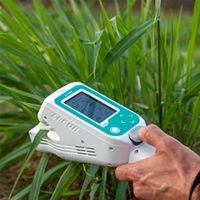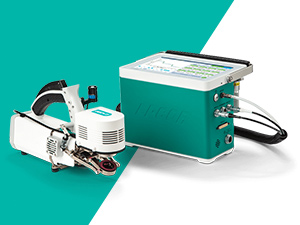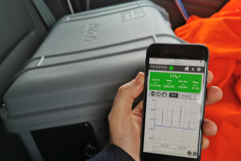
|
JUNE NEWSLETTER
A few highlights in this issue:
- See how Australian researchers used the LI-600 Porometer/Fluorometer
- Find out about our upgrade to the LI-6800 Portable Photosynthesis System
- Watch a video on measuring soil CO2 and CH4 exchange in a drained peatland site
- Register for our Stationary Concentration Measurements and Mobile Monitoring Webinar
- View a recording of Part 1 of the Measuring Urban GHG Emissions and Concentrations webinar series
- Find out how LI-COR CO2 analyzers and Apollo SciTech's applications of the analyzers in automated systems work to measure DIC or pCO2
- Sign up to be notified when the free, updated eddy covariance book is released
Find out how scientists in Australia used the LI-600
AN LI-600 TRIAL EXPERIENCE
When Professor David Ellsworth received a trial of the LI-600 Porometer/Fluorometer, he measured treetops at EucFACE, a free air CO2 enrichment research facility located in Australia’s Cumberland Plain Woodland. Ellsworth and his group of undergraduate and master’s students tested the instrument on 100-year-old leaves. They called the LI-600 easy to use, powerful, and flexible.
"I’m impressed that an undergrad student can use this instrument fairly easily — that’s testament to its usability."
- PROFESSOR DAVID ELLSWORTH
|
|
Read the Story
|
|
|
|
|
 |
Win your own free
trial of an LI-600.
Enter for the chance to field
test the LI-600 and see
firsthand why we love it.
Sign Up Now
|
|
|
Check out the upgraded processor in the LI-6800
|
|
When he first used the LI-6800 Portable Photosynthesis System in 2016, Randy Long of the University of California in Santa Barbara called it “a joy to use.” He said his two favorite features of the instrument were its speed and its user interface. Since 2016, the capabilities of the LI-6800 have expanded into applications including soil gas flux, insect respiration, and an aquatic chamber.
Continuing this trend of innovation, the LI-6800 now includes a Quad Core Plus processor in all new LI-6800s and as an upgrade for all instruments purchased from 2016 until Spring 2021. The processor replaces a single-core processor and allows the instrument’s touch screen to respond instantly, giving you faster access to your measurements of a plant’s response to rapidly changing conditions.
|
|
|
|
|
|
|
|
Contact us for more information about the Portable Photosynthesis System or for details about upgrading your LI-6800.
|
 |
|
Email US
|
|
|
See how Finnish researchers measured soil CO2 and CH4 exchange in a drained peatland
Researchers at Luke Natural Resources Institute in Finland are using the LI-COR LI-7810 CH4/CO2/H2O Trace Gas Analyzer for measuring soil CO2 and CH4 exchange in the drained peatland site Ränskälänkorpi. The group has measured heterotrophic soil respiration by limiting root growth using a trenching method and root prevention fabric.
Watch the video to hear them explain how the LI-COR Trace Gas Analyzer stabilizes quickly to save you time in your research.
Watch the video
|
|
Register for Part 2 of our Eddy Covariance Webinar
STATIONARY CONCENTRATION MEASUREMENTS AND MOBILE MONITORING
Using stationary concentration measurements and mobile monitoring of carbon and methane emissions, researchers are addressing the urban impact on greenhouse gas emissions. In Part 2 of our webinar series on measuring urban greenhouse gas emissions and concentrations, learn how stationary concentration measurements and mobile applications for analyzers can be used to provide real data with actionable insights.
|
Wednesday, June 16
Join us at
10:00 AM CDT
or
8:00 PM CDT
|
 |
|
Register Now
|
|
In case you missed it: Part 1 of the webinar
QUANTIFYING AN URBAN CARBON FOOTPRINT WITH DIRECT MEASUREMENTS OF GAS EMISSIONS
Eddy covariance measurements of urban emissions can provide higher resolution data with better precision than proxy estimates and indirect measurements. For example, direct eddy covariance measurements can help determine if efforts to reduce emissions are effective by quantifying the change over time. Learn how you can use this information for urban planning, zoning, transportation decisions, policies, regulations, and safety for urban development at local and national levels.
Watch the Recording
|
|
New pCO2 and DIC solutions with integrated LI-COR analyzers
AN INTEGRATED pCO2 AND DISSOLVED INORGANIC CARBON SYSTEM FOR OCEAN SCIENCE
Find out how LI-COR CO2 analyzers and Apollo SciTech's applications of the analyzers in automated systems work to measure dissolved inorganic carbon or partial pressure of CO2. In a webinar hosted on May 4, Apollo SciTech introduced its pCO2 and Dissolved Inorganic Carbon (DIC) systems. Apollo's DIC system is based on the LI-COR LI-7815 CO2/H2O Trace Gas Analyzer and the LI-850 CO2/H2O Analyzer.
View the recording to see a short introduction of the LI-7815 and the LI-850 before Apollo SciTech presents an overview of its integrated systems designed for ocean science.
Watch the Video
|
|
Updated Eddy Covariance Method book
BE THE FIRST TO KNOW WHEN THE FREE BOOK IS AVAILABLE
Dr. George Burba’s upcoming book Eddy Covariance Method for Scientific, Industrial, Agricultural, and Regulatory Applications will include the latest information on eddy covariance flux measurements. The free, updated edition features improved workflow descriptions and reviews of the latest developments.
Get a notification when the updated edition is released this summer!
Sign Up Now
|
|
Training
|
Photosynthesis Training
7-8 September
Online - Europe
21-23 September
Lincoln, Nebraska, USA
12-13 October
Lincoln, Nebraska, USA
16-17 November
Lincoln, Nebraska, USA
7-9 December
Lincoln, Nebraska, USA
|
|
Register
|
Eddy Covariance Training
14-16 September
Lincoln, Nebraska - USA
5-7 October
Online - Europe
|
|
Register
|